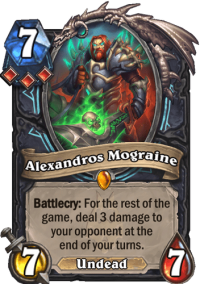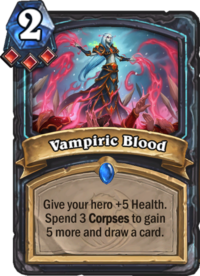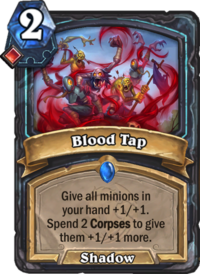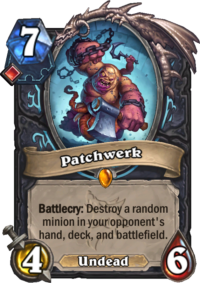The new Death Knight class is coming to Hearthstone in the March of the Lich King expansion on December 6. This is by far the biggest new thing Hearthstone has ever launched, as Death Knight arrives with a whopping 68 new cards.
However, you cannot use all Death Knight cards in all decks. The class comes with a new deck-building system called runes. There are three types of Death Knight runes: Blood, Frost, and Unholy. You can use three runes in a deck, and they can be any combination of the three types, from using one of each to using three runes of the same type. Generally, the stronger cards are locked behind multiple runes of the same type, so you have to pick and choose what to focus on. You can use any Death Knight cards that match your rune selection in your deck: if you use two Blood runes, for example, you can add all cards that require one or two Blood runes into your deck.
In this article, I will venture into Blood Death Knight. Triple Blood is the main Death Knight control archetype. Double Blood supports handbuffs and some control elements. Single Blood comes with some surprisingly strong cards and is possibly the strongest rune type to splash into other Death Knight decks to open access to multiple tools. I will discuss what Blood offers for other Death Knights too, although the main focus here is on the triple and double Blood rune decks.
Blood Death Knight in World of Warcraft
The inspiration behind Blood Death Knight is the Blood Death Knight spec in World of Warcraft. Blood is the tank spec in that game, capable of surviving immense damage through damage mitigation and self-healing. It is slow at dealing damage, but in questing content, Blood Death Knights are nigh unkillable. They truly shine in group content and raids, where they keep the attention of the bosses on themselves while the rest of the group deals damage and helps the Blood Death Knight survive.

Blood Death Knight has some of the biggest lore cards in this expansion. Alexandros Mograine and Corrupted Ashbringer are huge parts of the original World of Warcraft. The world was full of rumors about the fate of Alexandros, known as The Ashbringer, and his legendary sword of the same name that could destroy swarms of undead. Players tried to find the blade in the game for a long time, but to no avail. Eventually, with the release of the original Naxxramas raid, Alexandros Mograine was found as an undead Death Knight in service of the Lich King. He was one of the original Four Horsemen, and one of the items players could get from defeating the encounter was Corrupted Ashbringer. Attempts to purify the blade were all unsuccessful. Years later, The Ashbringer was finally purified by Tirion Fordring at the start of the Wrath of the Lich King expansion.
Other major Blood Death Knight lore cards include Patchwerk, who is an iconic boss fight in the Naxxramas raid, and Deathbringer Saurfang, a Horde hero who was defeated by The Lich King, raised to undeath, and serves as a boss fight in the Icecrown Citadel raid.
If you are interested in the lore aspects of Blood Death Knight, you can find more stories about it in this video:
Triple Blood – The Control Death Knight Deck
Triple Blood is as slow as it gets for Death Knight. Here is an example of what a full-on Control Death Knight could look like.
First, note the strong disruption capabilities Death Knight has. Patchwerk is just mind-boggling, and together with Theotar, the Mad Duke, Mutanus the Devourer, and Brann Bronzebeard, Death Knight has potential to steal or destroy almost any win conditions.

Death Knight can also gain a lot of health thanks to Vampiric Blood. Spell discovery is a strong effect for the class, and can potentially give you even more copies of Vampiric Blood among other things, resulting in some potentially crazy health levels. We might not quite hit Odd Warrior armor totals of old, but some big numbers are to be expected. Venomous Scorpid, School Teacher, and Hematurge are here to benefit from the generous Discover pools available to Death Knight.
As for the final win condition, the deck packs three of them. Sire Denathrius and Astalor Bloodsworn are a given, and I want to give Alexandros Mograine a try as well. I’m afraid Alexandros may end up being too weak to see play, but the early days are the best time to give him a chance.
Defensive strategies have not been strong enough to win in Hearthstone as of late. If you do not crumble under the pressure of one big minion after another from a Beast Hunter, there will eventually be a giant Sire Denathrius to finish things off. I’m uncertain whether Blood Death Knight can gain enough Health to get out of reach, but this list is trying its utmost to get there.
Double Blood, Single Unholy – The Handbuff Death Knight Deck
The main direction of double Blood is handbuffs, and the best complement to those handbuffs is Unholy.
Blood Tap is the key card here. It is a potentially significant buff that attempts to carry the deck. There is also an attack buff from Darkfallen Neophyte, but health is generally more important. Every successful token deck in Hearthstone has found a way to add more Health to its token board, and the same principle applies to handbuffs.

Once you get some buffs going, there are plenty of payoff cards: Encumbered Pack Mule is an old favorite, as are Ram Commander and Blademaster Samuro. New Death Knight cards provide even bigger potential payoffs with Malignant Horror and Nerubian Swarmguard summoning copies of themselves, making them perfect targets for buffs.
I also have high hopes for Gnome Muncher to provide a big swing when buffed.
Finally, the deck includes three slower cards. Sire Denathrius, Astalor Bloodsworn, and Patchwerk provide the deck with further damage in case its immediate handbuff plan fails to end the game. I thought a lot about whether to include these cards, but as handbuffs are not that fast anyway, I figured there might be room for a couple of slower cards in the mix. Also, Patchwerk is so mind-numbingly strong in any game that goes past turn seven that it is hard to ignore.
Double Blood, Single Frost – The Burn Death Knight Deck
The combination I struggled with the most was double Blood, single Frost. I would really like to reverse this into double Frost, single Blood, as double Blood does not bring much to the table. Double Blood is needed for handbuffs, but Frost does not bring any good targets for those, unlike Unholy. Double Blood can also support a control strategy, but single Frost does not give you a lot of tools to build a control deck. With Sire Denathrius the typical finisher in a modern control deck, Frost’s abundance of spells is a poor fit. Perhaps it could be possible to build a Prince Renathal control deck with double Blood and single Frost, but its ability to end games seems questionable.
Therefore, I ended up with this burn deck:
This deck has a lot of spells that can go face, and some of them can clear boards at the same time. Talented Arcanist combined with Remorseless Winter deals four damage to all enemies for six mana. Howling Blast can likewise be combined with Spell Damage minions for greatly increased effect.
The deck also features minions that can Discover more spells, although I skipped Hematurge as I’m not sure I want more Blood cards.
The only use of double Blood in this list is Corrupted Ashbringer which serves as a finisher. I could have added Hematurge, Blood Boil, and Corpse Explosion for some additional defensive capabilities. Perhaps there is a balance that can be found there, also potentially including Prince Renathal for more starting health. Nonetheless, I wanted to use this more consistent list as a starting point. Once it is possible to play with it, it can be determined whether it has enough damage to end games and whether it needs more survivability to do so.
Splashing Blood in Other Death Knight Decks
Blood is perhaps the strongest rune to splash into a deck of other runes. Splashing is a term from Magic that refers to adding just a couple of cards of a specific color to your deck, and it seems suitable to describe the practice of adding a single rune to your Death Knight deck in Hearthstone.

The obvious big card to splash is Patchwerk. The sheer disruption brought about by that single card is crazy. Destroying stuff from the board, hand, and deck simultaneously is totally bonkers. Patchwerk is guaranteed to go at least three-for-one every time!
Gnome Muncher is not far behind. It heals, it destroys minions, and it can even go face. What is there not to like?
The third big card to splash is Noxious Cadaver. Sure, it is a simple one-cost minion, but it can often take something out when it enters the board, not to mention that it can also deal immediate face damage.
No other rune provides such power and versatility with the expenditure of just a single rune.
There are more single-rune cards available, and some of them may be situationally useful, such as Heart Strike, but the above trio really raises the bar for other runes when it comes to the value a single rune can add to a deck.
Conclusions
Blood is the most potent control archetype for Death Knight. The rune also includes Death Knight’s handbuff support, although that aspect of the class is less refined. In the Death Knight showmatch, Blood was by far the weakest contender. Perhaps this was because of deck-building decisions, or perhaps playing slow control remains a futile effort in Hearthstone. Either way, Blood is trying to keep control decks alive in the game. Even if Blood decks fail, Blood has some great single-rune cards which should ensure that people will often want to splash Blood into their Death Knight decks.
Leave a Reply
You must be logged in to post a comment.














































The disruption quality of the 1st deck looks scary. The only thing I don’t like is the fact that Denathrius is pretty weak in this deck.
Bran Bronzebeard might be DKs MVP at the start of the expansion. Him and Patchwerk together will ruin dreams for sure.
Btw Patchwerk isn’t a guaranteed to 3-for-1. There are decks (albeit only few) that don’t play that many minions. 😉
Denathrius will work if you add Boneguard Commander and Onyxia to that deck.
Yeah, but the deck will get very top-heavy, then. Maybe the life gain will be enough, but I doubt it.
Triple blood has extreme survivability tools. What it lacks is ways to finish the game. Because of outcrys, they removed all unique finishers except neutral Renathal / Denathrius minion piles (and even then, slow decks fight like wet noodles). So, if triple blood isn’t DoA, it’s going to need Dena win-con + disruption. Astalor alone isn’t enough. Commander is perfect for infusing Dena. A very underrated minion. This deck needs Finley, too. Draw is lacking and I hope we can include something better than Fools.